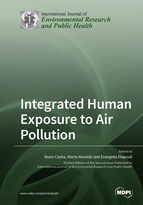Integrated human exposure to air pollution
A special issue of International Journal of Environmental Research and Public Health (ISSN 1660-4601). This special issue belongs to the section "Environmental Science and Engineering".
Deadline for manuscript submissions: closed (31 October 2020) | Viewed by 51828
Special Issue Editors
Interests: indoor air quality; ventilation; sleep; biodiesel; aerosols; biomonitoring; schools; assessment of pollution sources; atmospheric pollution; human exposure; air quality
Special Issues, Collections and Topics in MDPI journals
Interests: low-carbon economy; citizen science; environment assessment; air quality
Special Issues, Collections and Topics in MDPI journals
Interests: aerosol physico-chemical properties; indoor air quality; source apportionment; occupational exposure
Special Issues, Collections and Topics in MDPI journals
Special Issue Information
Dear Colleagues,
Air pollution is one of the major environmental health problems that people face nowadays, affecting everyone in the world. The World Health Organization has estimated that, in 2016, ambient air pollution caused 4.2 million premature deaths worldwide, in both cities and rural areas, while household air pollution caused 3.8 million deaths, mainly in low and middle-income countries.
Usually, citizen exposure to air pollutants is calculated based only on concentrations of pollutants monitored using air quality monitoring stations from environment national agencies. These monitoring stations focus on outdoor air quality and, most of them, are located in urban centres. However, this approach fails to account for all components of exposure since:
- There is a high variability of air pollutant concentrations within a city, depending on the city topography and the existence (or not) of specific pollution sources (such high traffic areas);
- The time–activity patterns and the use of spaces is very heterogeneous within the population;
- People spend around 90% of their time in indoor environments.
Therefore, human exposure during a full day cannot be reflected only by outdoor exposure and should consider all micro-environments where individuals spend their time (e.g., home, workplace, transports, leisure, and others) and the time spent in them.
The characterization of indoor and outdoor environments is essential to understand the integrated human exposure to air pollutants. With this Special Issue, we invite colleagues to contribute to increase the knowledge about human exposure in different micro-environments, specific exposures that individuals are under when performing specific tasks, methodologies to understand pollution sources and their impact on indoor and ambient air quality, with the main aim of developing the most effective mitigation measures to decrease human exposure and protect public health.
Dr. Nuno Canha
Dr. Susana Marta Almeida
Dr. Evangelia Diapouli
Guest Editors
Manuscript Submission Information
Manuscripts should be submitted online at www.mdpi.com by registering and logging in to this website. Once you are registered, click here to go to the submission form. Manuscripts can be submitted until the deadline. All submissions that pass pre-check are peer-reviewed. Accepted papers will be published continuously in the journal (as soon as accepted) and will be listed together on the special issue website. Research articles, review articles as well as short communications are invited. For planned papers, a title and short abstract (about 100 words) can be sent to the Editorial Office for announcement on this website.
Submitted manuscripts should not have been published previously, nor be under consideration for publication elsewhere (except conference proceedings papers). All manuscripts are thoroughly refereed through a single-blind peer-review process. A guide for authors and other relevant information for submission of manuscripts is available on the Instructions for Authors page. International Journal of Environmental Research and Public Health is an international peer-reviewed open access monthly journal published by MDPI.
Please visit the Instructions for Authors page before submitting a manuscript. The Article Processing Charge (APC) for publication in this open access journal is 2500 CHF (Swiss Francs). Submitted papers should be well formatted and use good English. Authors may use MDPI's English editing service prior to publication or during author revisions.
Keywords
- Air pollution
- Assessment and modelling
- Biomass burning
- Chemical pollutants
- Economic impacts and policies
- Epidemiology
- Exposome
- Household air pollution
- Human exposure
- Human health
- Health risk assessment
- Indoor air pollution
- Low cost sensors
- Pollution mixtures
- Source apportionment
- Toxicity
- Ventilation








